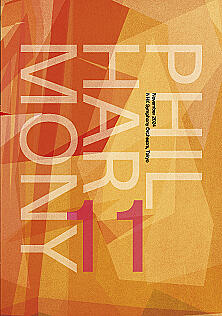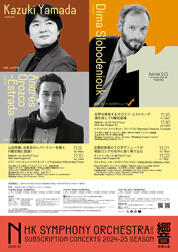- Home
- Concerts
- Subscription Concerts 2024-2025
- Program A
- No. 2022 Subscription (Program A)
No. 2022 Subscription (Program A)
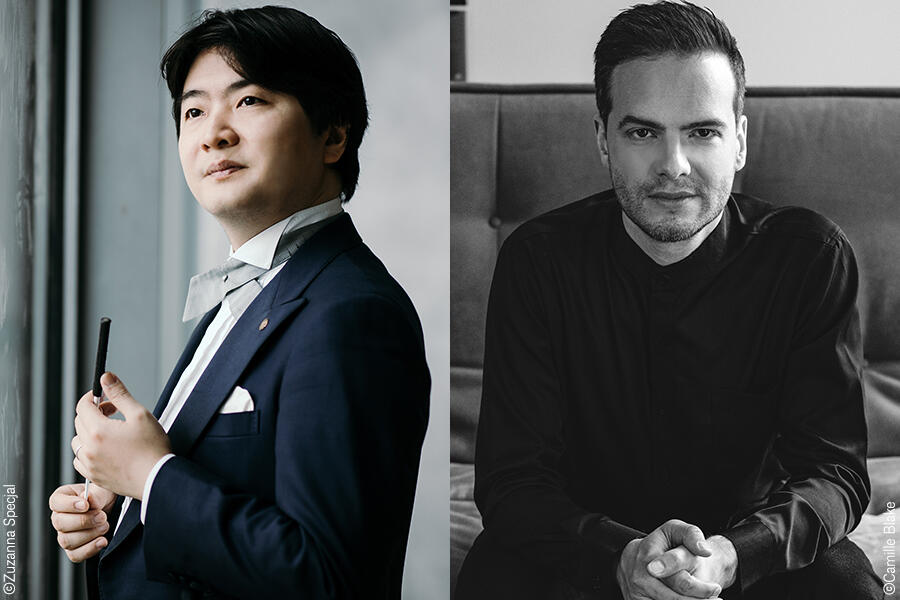
Program
Roussel / Bacchus et Ariane, ballet Op. 43—Suite No. 1 (Bacchus and Ariadne)
Seven-year junior to Debussy, French composer Albert Roussel (1869–1937) received a fully-fledged musical education only after leaving the Navy at age 25, though he had displayed his extraordinary musicality from childhood. His style was first affected by his teacher d’Indy (Franck’s pupil) and then Debussy’s Impressionism before showing a neo-Classical tendency. At any rate, Roussel’s originality always resides in his rather horizontal, linear, polyphonic mindset (he was a renowned professor of counterpoint) and, above all, powerful rhythms.
The two-act ballet score Bacchus et Ariane (Bacchus and Ariadne 1931) is from Roussel’s mature period. Based on Greek mythology and set in Naxos, the ballet features Ariadne, a Cretan princess, and Bacchus (Dionysus), a god of wine, who become a couple: the story is a sequel to the hero Theseus’ defeat of the monstrous Minotaur in Crete and Theseus’ escape from there with Ariadne.
The Suite No. 1 prepared from Act 1 by Roussel himself is in five major sections performed without pause. The second section has young companions (who landed in Naxos with Theseus and Ariadne) celebrate Theseus’ victory over the monster. The third section hints at the Cretan Labyrinth with meandering melodies and lets Theseus reenact his battle against Minotaur. Bacchus appears in the fourth section putting Ariadne to sleep and forcing Theseus to leave Naxos without her. We then hear lightning caused by Bacchus’ angry father Zeus (Jupiter). During the fifth section, Ariadne dances with Bacchus passionately in her dream before being left slumbering alone on a rock.
[Kumiko Nishi]
Bartók / Piano Concerto No. 3
Hungarian composer Béla Bartók (1881–1945) began piano lessons with his mother at five and started to compose soon after, before studying piano and composition at the Budapest Academy of Music. Considered nowadays a father of ethnomusicology, he collected and analyzed numerous folk songs and dances mainly of Eastern Europe. As a classical composer, he was inspired both by folklore and his forerunners including Debussy and Stravinsky to create his innovative works which had a great impact on modernism in music.
One of Bartók’s turning-points was his move to the USA in 1940. Although not Jewish, he left Europe to protest the Nazis. He spent his last years terminally ill and destitute in New York and passed away in exile in September 1945. However, a handful of his compositions from this difficult period are incredibly inspiring, of which the Piano Concerto No. 3 provides a great example. Bartók wrote it in the summer of 1945 while battling against leukemia. It was a birthday gift for his pianist wife, so she could gain income after his death by performing it. This is a reason why No. 3, stylistically less pioneering, differs from his progressive and percussively powerful Piano Concertos No. 1 (1926) and No. 2 (1931) composed for himself to premiere as the soloist. No. 3 was completed but the orchestration of the final seventeen bars. His friend Tibor Serly scored the bars for the 1946 premiere according to the shorthand left by Bartók.
The first sonata movement invites us to a folky, likely Romanian sound world with the opening unison melody on piano. The slow movement in A–B–A’ form, headed “religiously,” has the calm and divine beginning by strings and piano reminding us of Heiliger Dankgesang eines Genesenen an die Gottheit (A Convalescent’s Hymn of Thanksgiving to the Deity) that the ill Beethoven wrote as the slow movement of his String Quartet No. 15 Op. 132 (1825). Bartók’s contrastive central section resounds birdsongs that he is said to note down in North Carolina, USA. The rondo finale has a lively recurring theme which evokes a festive folk dance.
[Kumiko Nishi]
Ravel / Valses nobles et sentimentales (Noble and Sentimental Waltzes)
Maurice Ravel (1875–1937) and Debussy are often referred to in pairs. The former is, however, younger than the latter by no less than thirteen years and moreover, the styles that the two Frenchmen had are too varied to be lumped together into Impressionism. As for Ravel who was relatively unprolific, he always took a different approach to composing, whilst his constant clarity, minuteness and sophistication earned him a byname “Swiss Watchmaker.” Another nickname of his, “Magician of Orchestration,” is true of his masterly scoring which is the common feature of all his diverse orchestral works.
Originally, Ravel composed Valses nobles et sentimentales (Noble and Sentimental Waltzes) for piano in 1911. The title is a tribute to Schubert (1797–1828) who wrote twelve Valses nobles (D. 969) and thirty-four Valses sentimentales (D. 779). Ravel’s, with French grace and finesse, are nevertheless far beyond imitation of the Viennese master’s. Ravel then orchestrated the set for the ballet Adélaïde: ou le langage des fleurs (Adelaide: The Language of Flowers 1912) for which he wrote the scenario. Set in a Parisian salon in the 1820s, the story features Adelaide, a courtesan, and her two suitors. The epigraph (by Henri de Régnier) printed on the first edition of the piano version guides us to Ravel’s poetic sound world: “… le plaisir délicieux et toujours nouveau d’une occupation inutile (the delightful and ever-new pleasure of a fruitless occupation).” A highlight is the tranquil ending of the set, Épilogue, where all the previous waltzes are recollected in fragments.
[Kumiko Nishi]
Debussy / Images for Orchestra—Iberia
Born in a Paris suburb, Claude Debussy (1862–1918), a genuine early bloomer, was allowed to enroll in the Paris Conservatoire in 1872 at a mere 10 years of age. His ground-breaking compositions subsequently went on to have a great influence on music history in the 20th century by leaving the traditional language in terms of harmony, form and tone color.
Besides his intelligence as well as profound knowledge of literature and painting, Debussy’s open mind and lively curiosity about the foreign and the unknown surely helped him explore a novel path in classical music. Two of the several examples are the Javanese gamelan music he discovered at the 1889 Paris World’s Fair and the fascination with Spain that he got through reading, Bizet’s Carmen, his Spanish friends and so forth. One of Debussy’s early works immersed in Spanish exoticism is Soirée dans Grenade (Evening in Granada) for piano. To our surprise, he is said to have crossed the border between France and Spain only once in his life to watch a bullfight in a Spanish northeastern city as a day trip.
From Debussy’s mature period, Iberia was written in 1906–1909 as a part of Images for Orchestra. He originally intended Images to be a triptych for two pianos, but eventually entrusted the multicolor nature to the large orchestra: Images is indeed an orchestral work atypical of Debussy as the percussion stands out noticeably. With the three movements of Iberia, he vividly depicts his almost-imaginary Spain. Opened with castanets beating flamenco-like quick triplets out, I Par les rues et par les chemins (Along the Streets and Along the Paths) is animated and occasionally languorous: the principal theme is introduced immediately by two clarinets. This melody will be recalled towards the end of II Les parfums de la nuit (The Scents of the Night) which has the heading “slow and dreamy.” After a church bell rings, III Le matin d’un jour de fête (The Morning of a Festival Day) begins without pause. In march rhythm, the violinists and violists strum their instruments at times imitating guitars. Some themes from the preceding movements are heard again and then the radiant finale comes to a euphoric end.
[Kumiko Nishi]
[Encore]
November 9: Bach / Kempff / Wachet auf, ruft uns die Stimme BWV 645
November 10: Schubert / Impromptu G-flat Major Op. 90-3
Piano : Francesco Piemontesi
Artists
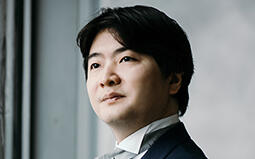 ConductorKazuki Yamada
ConductorKazuki Yamada
Kazuki Yamada retired from Principal Guest Conductor of the Yomiuri Nippon Symphony Orchestra at the end of March 2024, and with this, he has relinquished all positions he had held in major domestic orchestras to be ready to make his further career in Europe and North America. In May this year, he made his debut with the Chicago Symphony Orchestra’s subscription concert, and has successfully led the Japan tour of the Orchestre Philharmonique de Monte-Carlo, where he has held the positions of Artistic and Music Director, and was promoted to Music Director from Principal Conductor and Artistic Advisor of the City of Birmingham Symphony Orchestra. At almost the same time, it was announced that he would be appointed as Artistic Director (music category) of the Tokyo Metropolitan Theatre from April 2026 and also his debut with the Berliner Philharmoniker which has been scheduled for June 2025. It seems he will focus on conducting orchestras of Europe and North America, and apply the ideas he has earned from the concerts with the world foremost orchestras to projects and events held in Japan, in an effort of exploring a new form of concerts as well as expansion of audience.
In this collaboration with the NHK Symphony Orchestra, he has lined up masterpieces of French modern composers such as Roussel, Ravel, Debussy, for which he has polished his interpretation during the time as Principal Guest Conductor of the Orchestre de la Suisse Romande (2012–2018) and the Orchestre Philharmonique de Monte-Carlo, and work with Swiss pianist Francesco Piemontesi performing Concerto of Bartók, a contemporary composer of those of French works.
Recently, supported by his extensive conducting career in Europe and America, he has sharpened his ability to delve deeper into the core of the works he conducts, while also broadening his range of approaches to make it easy for his audience to appreciate music. This can be described as the second culmination of his career surpassing the first which spans from winning the Besançon International Conducting Competition in 2009 to assuming the posts simultaneously with the Orchestre de la Suisse Romande, the Japan Philharmonic Orchestra, and the Sendai Philharmonic Orchestra in 2012.
[Takuo Ikeda, music journalist]
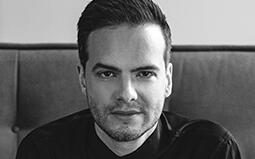 PianoFrancesco Piemontesi
PianoFrancesco Piemontesi
Francesco Piemontesi was born in Locarno, an Italian-speaking region of Switzerland in 1983. He studied under Arie Vardi, Alfred Brendel, and Cécile Ousset, and won 3rd place at the Queen Elisabeth International Music Competition in 2007. Since then, he has started his international career and has constantly been invited to world’s foremost orchestras. In 2014, he first appeared with the NHK Symphony Orchestra under the baton of Roger Norrington, playing Beethoven Piano Concerto No.1, and made his debut with the Berliner Philharmoniker in 2020 with Mozart Piano Concerto No.27 under Lahav Shani. He serves as Artistic Director of the Settimane Musicali di Ascona, a music festival held by Lake Maggiore in the Italian-speaking region of Switzerland.
He has been well known for works from Classical to Romantic period composers such as Mozart, Beethoven, Schubert, Schumann and Liszt, however in recent years, he has also been working on modern and contemporary period works, and has recorded works for piano and orchestra by Ravel, Messiaen and Schönberg with the Orchestre de la Suisse Romande under Jonathan Nott. The Bartók Piano Concerto No.3 he will perform is sure to gather quite a lot of attention.
[Haruo Yamada, music critic]
Download
Ticket
Program A
No. 2022 Subscription (Program A)
NHK Hall
Google Map
Seating Chart
Single Tickets Release Date
Pre-sales for Subscribers:Wednesday, July 31, 2024
*about subscribers
Sale to General Public:Sunday, August 4, 2024
Price
| S | A | B | C | D | E | |
|---|---|---|---|---|---|---|
| Ordinary Ticket | 10,000 | 8,500 | 6,500 | 5,400 | 4,300 | 2,200 |
| Youth Ticket | 5,000 | 4,000 | 3,100 | 2,550 | 1,500 | 1,000 |
Seating chart Enlarge Print PDF
*tax included
*Subscribers receive a 10% discount (Available at NHKSO WEB Ticket and N-Kyo Guide)
*For wheelchair-accessible seats, please refer to the N-Kyo Guide
Youth Tickets
Youth Tickets are great options for those of 29 years old and younger
Subscription tickets
Release Date
ANNUAL SUBSCRIPTION TICKETS/
SEASONAL SUBSCRIPTION TICKETS (AUTUMN)
Mon., July 15, 2024 10:00am
[For Subscribers: Sun., July 7, 2024 10:00am]
Where to buy
NHKSO WEB Ticket | Saturday, November 9 (In English / Seats not selectable)
NHKSO WEB Ticket | Sunday, November 10 (In English / Seats not selectable)
NHKSO WEB Ticket (In Japanese only / Seats selectable)
N-Kyo Guide (Purchase by telephone only)
Other Ticket Agents
Broadcast
 NHK-FMNo. 2022 Subscription (Program A)
NHK-FMNo. 2022 Subscription (Program A)
Thursday, Nov 28, 2024 7:30PM - 9:10PM
Program:
Roussel / Bacchus et Ariane, ballet Op. 43—Suite No. 1 (Bacchus and Ariadne)
Bartók / Piano Concerto No. 3
Ravel / Valses nobles et sentimentales (Noble and Sentimental Waltzes)
Debussy / Images for Orchestra—Iberia
Conductor:Kazuki Yamada
Piano:Francesco Piemontesi
Recorded:November 9, 2024 NHK Hall
*Repertoire, conductor, soloists and program order are subject to change without notice.
*Pre-school children are not allowed in the concert hall

